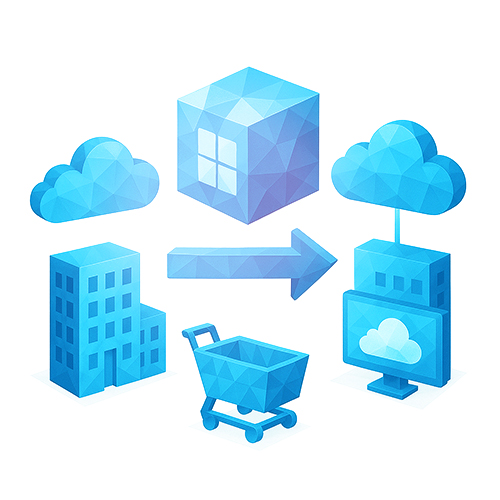
Table Of Content
Microsoft 365 Tenant-to-Tenant Migration | Complete 2025 Guide

Moving from one Microsoft 365 tenant to another can feel like navigating a complex maze. Whether it’s due to a company merger, acquisition, divestiture, or rebranding, tenant-to-tenant migration is a critical process that requires careful planning and execution. This article dives deep into what Microsoft 365 tenant-to-tenant migration entails, why it’s important, and how to approach it effectively.
What Is Microsoft 365 Tenant-to-Tenant Migration?
At its core, a Microsoft 365 tenant is a dedicated instance of cloud services tied to an organization’s domain and subscription. Tenant-to-tenant migration means moving users, data, and configurations from one Microsoft 365 environment to another. This isn’t just a simple copy-paste operation; it involves migrating mailboxes, SharePoint sites, OneDrive files, Teams data, and more, all while maintaining security, compliance, and minimal disruption.
Imagine two companies merging, each with their own Microsoft 365 setup. To unify operations, IT teams need to consolidate these environments into a single tenant. This ensures seamless collaboration, centralized management, and cost efficiencies. But the process can be daunting without the right strategy and tools.
One of the critical aspects of tenant-to-tenant migration is understanding the dependencies between various Microsoft 365 services. For instance, when migrating Teams data, it’s essential to consider the associated channels, files, and conversations, as these elements are interconnected. Failure to account for these dependencies can lead to data loss or disorganization, which can hinder productivity in the new environment. Additionally, organizations must also evaluate their compliance requirements, ensuring that sensitive data is handled appropriately throughout the migration process.
Furthermore, planning is paramount in a successful tenant-to-tenant migration. Organizations often conduct a thorough assessment of both the source and destination tenants, identifying which data and users need to be migrated and in what order. This assessment can also highlight any potential issues, such as licensing discrepancies or feature availability differences between the two tenants. By developing a detailed migration plan that includes timelines, resource allocation, and risk management strategies, IT teams can significantly reduce the chances of encountering obstacles during the migration. Engaging with experienced migration specialists or using automated migration tools can also streamline the process, ensuring that the transition is as smooth as possible for all users involved.
Why Do Organizations Need Tenant-to-Tenant Migration?
Mergers and Acquisitions
One of the most common reasons for tenant-to-tenant migration is corporate restructuring. When businesses merge or acquire others, they often need to consolidate IT systems. Migrating Microsoft 365 tenants helps unify communication channels, standardize security policies, and streamline user management. This process not only enhances collaboration among employees from different organizations but also reduces the complexity of managing multiple tenants. By centralizing resources, companies can leverage shared tools and applications, leading to improved productivity and a more cohesive work environment.
Divestitures and Spin-Offs
Conversely, when a company spins off a division or sells a business unit, it may need to separate that unit’s Microsoft 365 environment. Tenant-to-tenant migration enables a clean split, ensuring that data and users belonging to the divested entity are moved securely and independently. This separation is crucial to maintain data integrity and compliance with regulatory requirements. Furthermore, it allows the newly independent entity to establish its own identity and operational processes without the encumbrance of legacy systems from the parent organization, fostering a fresh start that can drive innovation and growth.
Rebranding or Organizational Changes
Sometimes, companies rebrand or restructure internally, requiring a fresh Microsoft 365 tenant that aligns with new domains or organizational units. Migrating tenants can help align IT infrastructure with the company’s new identity and operational model. This transition not only involves technical adjustments but also necessitates a cultural shift within the organization. Employees may need training on new tools and processes, and communication strategies must be adapted to reflect the new branding. A successful migration can serve as a catalyst for change, encouraging teams to embrace new ways of working and enhancing overall engagement across the organization.
Improved Security and Compliance
Another critical aspect of tenant-to-tenant migration is the opportunity to enhance security measures and ensure compliance with industry regulations. As companies grow and evolve, their security needs often change, necessitating a review and upgrade of existing protocols. Migrating to a new tenant allows organizations to implement the latest security features offered by Microsoft 365, such as advanced threat protection and data loss prevention tools. This proactive approach not only safeguards sensitive information but also builds trust with clients and stakeholders, reinforcing the organization’s commitment to data security and compliance.
Streamlined IT Management
Tenant-to-tenant migration also simplifies IT management by reducing the number of tenants that administrators must oversee. With fewer tenants to manage, IT teams can focus their efforts on optimizing performance, enhancing user experience, and addressing any emerging issues more efficiently. This consolidation can lead to significant cost savings as well, as organizations can better allocate resources and reduce overhead associated with maintaining multiple systems. Ultimately, a streamlined IT environment empowers teams to be more agile and responsive to business needs, fostering a culture of continuous improvement and innovation.
Key Challenges in Tenant-to-Tenant Migration
Complexity of Data and Services
Microsoft 365 isn’t just email anymore. It’s a rich ecosystem including Exchange Online, SharePoint Online, OneDrive for Business, Microsoft Teams, Planner, and more. Each service has unique data structures and dependencies. Migrating all of these seamlessly is a complex task that requires a deep understanding of the platform.
Maintaining Data Integrity and Security
Data loss or corruption during migration can be disastrous. Ensuring that all emails, files, permissions, and metadata are preserved is paramount. Additionally, migrations must comply with regulatory requirements like GDPR or HIPAA, which adds another layer of complexity.
Downtime and User Impact
Businesses rely heavily on Microsoft 365 for daily operations. Any downtime or disruption can impact productivity and customer service. Minimizing downtime and ensuring a smooth transition for users is a major challenge during tenant-to-tenant migration.
Licensing and Cost Considerations
Licensing differences between tenants can complicate migrations. Organizations need to plan for license reassignment, potential overlaps, and cost optimization post-migration.
Planning Your Microsoft 365 Tenant-to-Tenant Migration
Assess Your Current Environment
Start by auditing your existing Microsoft 365 tenants. Identify the number of users, mailboxes, SharePoint sites, Teams channels, and other resources. Understanding the scope helps set realistic timelines and resource requirements.
Tools like Microsoft’s own FastTrack service or third-party audit tools can provide detailed insights into your tenant’s usage and configurations.
Define Your Migration Goals and Scope
Are you migrating all users and data or only specific departments? Will you consolidate multiple tenants into one or split a tenant into several? Defining clear goals helps tailor the migration strategy and avoid scope creep.
Choose the Right Migration Tools
Manual migration is impractical for most organizations due to the complexity and volume of data. Specialized migration tools like ShareGate, BitTitan MigrationWiz, or Quest On Demand Migration can automate and simplify the process. These tools handle mailbox migrations, SharePoint site transfers, Teams data, and more, often with built-in error handling and reporting.
Plan for Communication and Training
Inform your users well in advance about the migration timeline, expected changes, and any required actions on their part. Providing training or FAQs can reduce confusion and support calls during the transition.
Step-by-Step Tenant-to-Tenant Migration Process
1. Prepare the Source and Destination Tenants
Before migration begins, ensure both tenants are properly configured. This includes verifying domains, setting up user accounts, and configuring security policies. Remove any conflicting settings that might block data transfer.
2. Synchronize Identities
Identity management is crucial. If using Azure AD Connect, plan how to handle user identities in the destination tenant. Options include migrating users as cloud-only accounts or syncing on-premises Active Directory identities to the new tenant.
3. Migrate Mailboxes
Email is often the highest priority. Using migration tools, move mailboxes with all folders, calendar entries, contacts, and rules intact. Some tools support staged migrations to minimize downtime.
4. Transfer OneDrive and SharePoint Data
Files stored in OneDrive and SharePoint require careful migration to preserve permissions and metadata. Bulk migrations can be scheduled during off-hours to reduce impact.
5. Migrate Microsoft Teams
Teams data migration is one of the more complex tasks due to the integration of chats, files, channels, and apps. Some migration tools support Teams migration, but it’s important to test thoroughly to ensure no data is lost.
6. Validate and Test
After migration, validate that all data has been transferred correctly. Test user access, mail flow, file permissions, and Teams functionality. Address any issues promptly.
7. Decommission the Old Tenant
Once confident that the new tenant is fully operational, plan the decommissioning of the old tenant. This includes canceling subscriptions and archiving any residual data.
Best Practices for a Successful Migration
Start with a Pilot Migration
Testing the process with a small group of users helps identify potential pitfalls and allows you to refine the migration plan before a full rollout.
Maintain Clear Documentation
Document every step, configuration change, and decision. This helps with troubleshooting and provides a reference for future migrations or audits.
Engage Stakeholders Early
Include IT, compliance, security, and business leaders in planning to ensure all requirements are met and risks are mitigated.
Schedule Migrations During Off-Peak Hours
To minimize disruption, plan migrations during nights or weekends when user activity is low.
Prepare for Post-Migration Support
Users will likely have questions or encounter issues after migration. Ensure your helpdesk is ready with resources and trained staff to assist.
Common Pitfalls to Avoid
Underestimating Data Volume and Complexity
Many migrations fail because the scope was underestimated. Take time to analyze data volumes and service dependencies accurately.
Ignoring Compliance and Security Requirements
Failing to maintain compliance during migration can lead to legal and financial penalties. Always consider data residency, encryption, and audit trails.
Neglecting User Communication
Poor communication leads to confusion and frustration. Keep users informed throughout the process.
Overlooking Third-Party Integrations
Microsoft 365 often integrates with other business applications. Ensure these integrations are accounted for and tested post-migration.
How Long Does a Tenant-to-Tenant Migration Take?
The timeline varies widely depending on factors like the number of users, data volume, complexity of services, and migration approach. Small migrations might take a few days, while large enterprises could require several weeks or even months of planning and execution.
Realistic scheduling and buffer time for unexpected issues are essential for success.
Conclusion: Making Tenant-to-Tenant Migration Work for You
Microsoft 365 tenant-to-tenant migration is a challenging but manageable process with the right preparation, tools, and mindset. Whether driven by mergers, divestitures, or organizational changes, a well-executed migration can unify your digital workspace, enhance collaboration, and reduce IT overhead.
Investing time in thorough planning, engaging stakeholders, and leveraging proven migration tools will help ensure a smooth transition with minimal disruption. Remember, the goal is not just to move data but to empower users and support business continuity throughout the change.
With careful execution, your Microsoft 365 tenant-to-tenant migration can be a stepping stone to a more agile, secure, and efficient cloud environment.
Looking for expert help with your Microsoft 365 tenant migration?
Techverx provides reliable migration services to ensure a seamless transition.
Contact us today to streamline your business processes and enhance your cloud infrastructure.

Rachel Kent
Rachel Kent is a Technology Advisor at Techverx based in McKinney, Texas, specializing in digital strategy, scalable architectures, and “right-fit” solutions. With a background as a Software Engineering Lead and full-stack engineer across healthcare and tech, she bridges business goals with modern stacks to rescue stalled projects, modernize legacy systems, and deliver ROI-focused outcomes.
Hiring engineers?
Reduce hiring costs by up to 70% and shorten your recruitment cycle from 40–50 days with Techverx’s team augmentation services.
Related blogs


